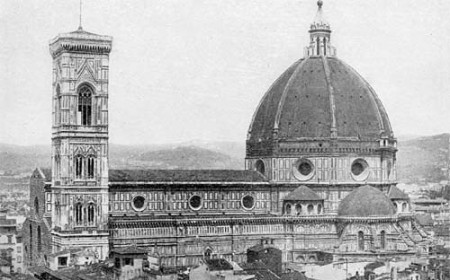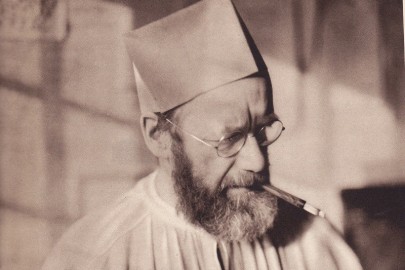
Music composed in the fifteenth century that will always be in tune with the cosmos…
On March 25th 1436, Florence cathedral was consecrated by Pope Eugenius IV. In his two years in the city, the Pope had not, thus far, set foot outside the monastery of Santa Maria Novella where he was lodged, but for the occasion of the dedication he made his way over a specially raised wooden walkway decorated with rugs and tapestries to the Duomo, accompanied by various ecclesiastical and civic dignitaries, and a train of musicians.
We do not know whether the musicians played or not at this point, but we do know that as part of the service of dedication a specially composed motet by the great French composer Guillaume Dufay (c.1400-1474) – Nuper rosarum flores – was performed.
Contemporary accounts describe how the motet echoed and resounded in the new dome to the ecstatic delight of all present, but beyond its sensory appeal, the fame of the motet is grounded on the use Dufay makes of inaudible numerological patterns, which govern in great detail both its rhythmic, textual, and intervallic structure.
Nuper rosarum flores is constructed in four symmetrical sections (with a concluding Amen), each of seven lines, each line of seven syllables. Each section is in four sung parts (triplum, motetus, and the two lower, tenor voices), and begins with the two upper voices singing for a total of 28 breves (realised in modern notation as 28 measures, or bars); these upper voices are then joined by the two lower voices, the tenor, singing the Gregorian cantus firmus – the first 14 notes of the introit for the dedication of a church, (terribilis locus iste) presented in alternating seven-note groups.
In this way the titular saint of the Cathedral of Santa Maria del Fiore – the vernal Virgin Mary – is programmed into the numerological patterns. The Virgin is associated with the number seven in medieval Christian exegesis, through her virtues, sorrows, acts of mercy, virginal companions, and years in exile. Four, the number of the temple (four cornerstones, four pillars, four walls) multiplied by seven is of course 28, a perfect number (a perfect number being one which is equal to the sum of its perfect divisors – in this case, 1, 2, 4, 7, and 14).
Each of the four sections is rhythmically governed by a different time signature, demanding respectively 6, 4, 2 and 3 minims to each breve (of which, recall, there are 28) – Pythagorean proportions. In 1973, Charles Warren suggested that these proportions were related to the layout of the Cathedral itself (length of nave to width of transept to height of dome, and so on) but more recently it has been shown by Craig Wright that mediating between the cathedral and the motet was the Temple of Solomon, whose stated proportions (60 cubits by 20 by 30) are identical to those expressed in the motet. An anonymous painting of Christ healing in the Temple, also dated 1436, confirms the identification of Duomo to Temple:

All this invisible patterning (and I have barely scratched the surface) is, to us, of ambivalent value. We are an age for whom our discoveries are more important than our inventions. Truth – truth about the cosmos, or the self, for example – is something elusive which you must find, or uncover, eke out; inventions are side-products of this quest, or the means by which we experimentally further it.
In 1436, the reverse was the case. The truth of the cosmos was known: it had been revealed. What was mysterious must remain mysterious, lodged in a cloud of unknowing. Everything else of value was made – constructed, in the most exalted cases, to accord with the principles and shape of the cosmos.
Dufay’s embedded patterns are at once an invention – a rhetorical inventio – and a something for us to discover and comprehend, hence our ambivalence. We like finding out the truth of the matter, but the motet itself does not conform to our expectations of an artwork – that it should be at some level a vessel of discovery.
There is however another, perhaps more interesting, way of looking at it, which might better reconcile us to it. The motet as a whole, and the details that make up its numerological component, and the broader contexts in which it is nested, are part of a complex, decentred network. The music, in other words, is connected, whether in an occult sense (for Du Fay) or in a more broadly cultural sense (for us) to any number of surrounding systems of meaning – to medieval typology and theology, to the platonic ideal of music as sounding number, to the history of Florence, the architectural design of Florence cathedral, and so on.
And these are not simple, hierarchical connections. The motet is not a microcosmic working out of broader ideas – it is, to state the obvious, music, while neo-platonic ideals of music are ideas, not music. It is therefore neither an epitome of what used to be called the medieval world view, nor a mere building block of it. It has a scale of its own: it is not determined by, nor does it determine, the conditions of its existence, but is rather connected to them, to repeat, across a non-hierarchical but also non-homogenous network.
I confess I am starting to think of Nuper rosarum flores as a cultural super-node, a well-oxygenated region of the quattrocento Florentine brain; an ecclesio-musical object comprising both cathedral and motet, which is at once temporally and spatially precise – Florence, 25th March 1436 – and temporally and spatially diffuse, stretching both back and forth in time (back to scholastic biblical exegesis, for example, and forward to Renaissance neo-Platonism); and in and out in space: in, to Guillaume Dufay’s head, or out, to Rome, Cambrai, Paris; and, just at this moment, to distant, neuronal Norbiton.










Interesting music, or is it maths? I am reminded of Mandelbrot’s fractals
yes, bonkers but beautiful